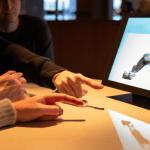Charting a New Course for Robotic Process Automation in Highly Secured Environments
In a world where companies are under immense pressure to improve their bottom line, finding ways to boost productivity while reducing costs has become a top priority. A recent study by McKinsey has revealed that the United States could grow its cumulative GDP by a staggering $10 trillion by 2030 if productivity is boosted to past historical rates. With the emergence of Robotic Process Automation (RPA) 2.0, technology can help. This intelligent solution, which combines the power of Artificial Intelligence (AI) and machine learning, is changing the game for businesses by automating more complex tasks and improving efficiency.
The adoption of Robotic Process Automation (RPA) has revolutionized the way businesses operate, streamlining operations and reducing costs by automating repetitive and time-consuming tasks. However, as industries like Aerospace & Defense and Healthcare seek to comply with strict security mandates while maximizing efficiency, the need for more intelligent and reliable process automation has become increasingly apparent.
This is where RPA 2.0 comes in. Leveraging AI and machine learning, RPA 2.0 can automate even more complex workflows non-invasively, making it an ideal solution for heavily regulated industries.
According to Gartner, almost 70% of human effort in management and processing will be automated by 2024, highlighting the vast potential for RPA 2.0. With new capabilities like intelligent computer vision, RPA 2.0 can analyze elements on the screen and drive software just like humans, making automation more reliable.
RPA 2.0 has advanced natural language processing (NLP). It understands the meaning and context of words and phrases, even when there are variations in language, dialect, or syntax. It learns from and adapts to new language patterns and variations over time, improving its ability to understand and respond to human language more accurately and effectively. Using NLP, RPA can automate responses to inquiries on the website, patient registration at kiosks, front-line administrative queries, and many other communication services. This improves communication, significantly shortens the time to diagnosis, increases efficiency, and leads to better outcomes in healthcare settings. Read On:


Comments
Charting a New Course for Robotic Process Automation in Highly Secured Environments — No Comments
HTML tags allowed in your comment: <a href="" title=""> <abbr title=""> <acronym title=""> <b> <blockquote cite=""> <cite> <code> <del datetime=""> <em> <i> <q cite=""> <s> <strike> <strong>